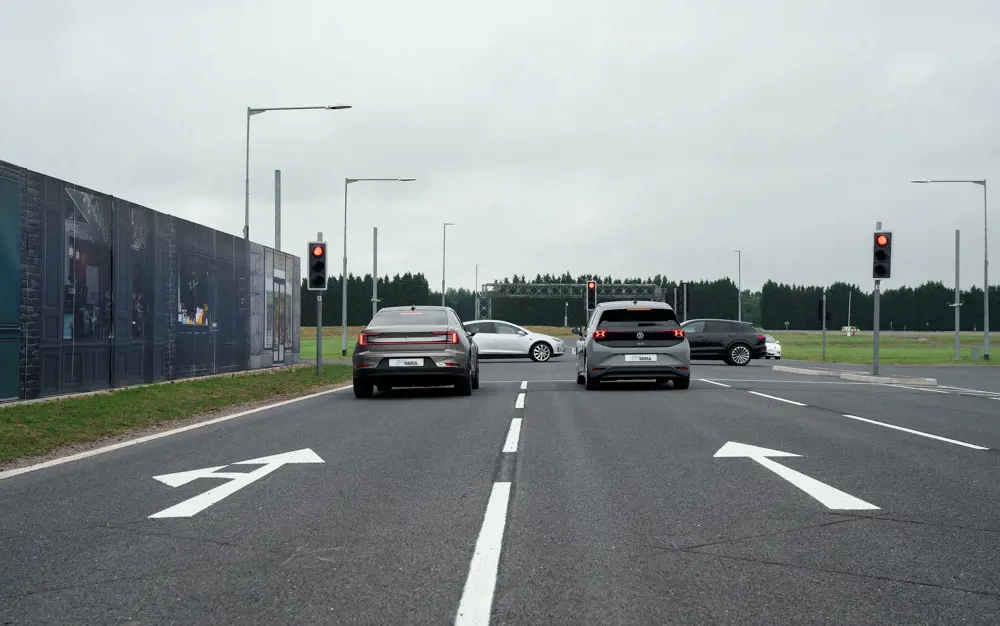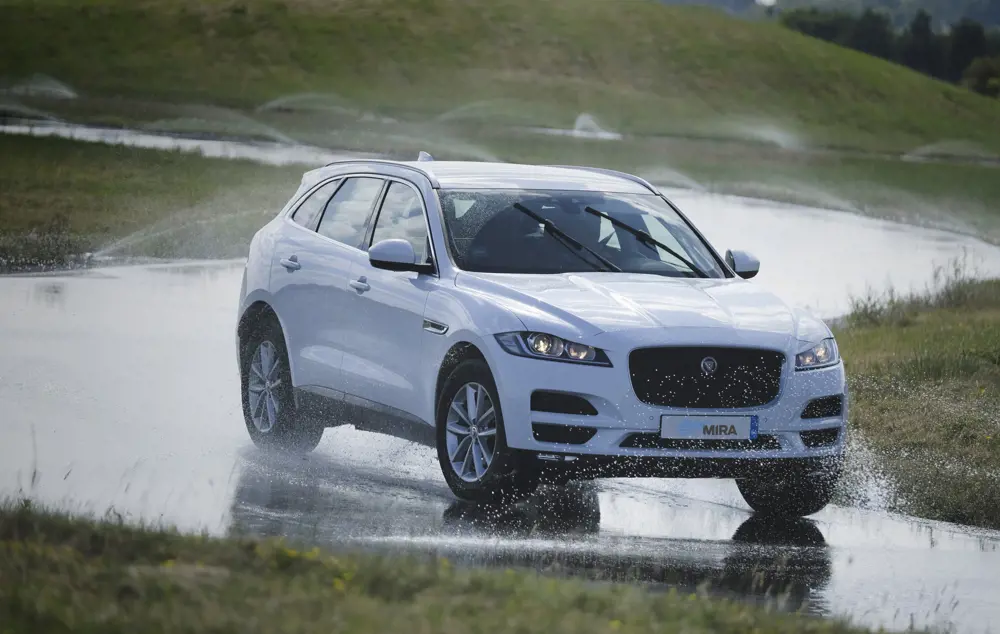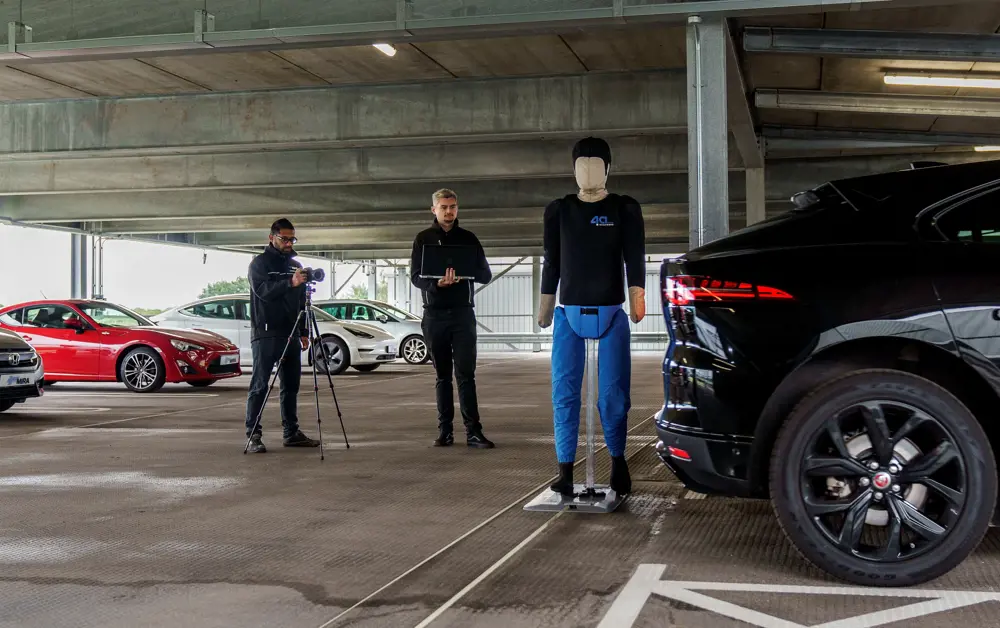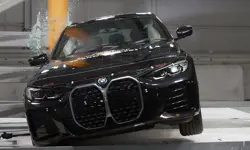
Testing new cars on a digital track
Did you know?
- Automotive-related manufacturing contributes £67 billion turnover and £14 billion value added to the UK economy, and manufacturers typically invest about £3 billion each year in R&D
- In 2022, over 775,014 cars, 101,600 commercial vehicles and 1.5 million engines were built in the UK, and 8 out of 10 cars produced in the UK are exported overseas to 130 different markets worldwide
- More than 1.6 million new cars are sold in the UK each year
The automotive industry is a vital part of the UK economy. More than 25 manufacturers build over 70 vehicle models in the UK, supported by 2,500 component providers and some of the world’s most skilled engineers. The rise in electrification and vehicles with advanced driver assistance and automated technologies, such as adaptive cruise control, autonomous obstacle avoidance and autonomous parking, is changing how automotive engineers develop and test new vehicles. A key player in the UK’s support system for car makers is HORIBA MIRA in Nuneaton. With a team of more than 500 staff, HORIBA MIRA, one of many automotive businesses on the MIRA Technology Park, maintains test equipment and road facilities that can subject vehicles – human-driven and autonomous, electric and combustion, civilian and military – to physical and virtual testing. Vehicle makers and their suppliers use this independent engineering and test consultancy to improve everything from durability to levels of autonomy on ‘self-driving’ cars.
The site is home to the MIRA Technology Park, a mobility technology cluster focused on automotive R&D. With more than 35 major companies on the site including Polestar, REE Automotive, ClearMotion, and Bosch, the technology park claims to be ‘Europe’s largest automotive R&D cluster’. As an ecosystem for the development of automotive technology, many tenant companies also use HORIBA MIRA’s vehicle development facilities co-located onsite.
Recreating real road conditions
A key component of automotive engineering is the ability to test new ideas in a real-world environment. To enable this important element of R&D, HORIBA MIRA opened a £100 million ASSURED CAV test ecosystem in 2022, for the engineering and testing of connected and autonomous vehicle (CAV) technologies. It contains an outdoor city circuit that recreates common features of built-up areas including traffic lanes, configurable junctions and a multistorey car park. The test circuit has wider use beyond the automotive industry: the telecommunications and electronics industries, as well as highways authorities, can carry out trials of intelligent transport systems (ITS) and telematics in a controlled environment. The city circuit is also a test bed for advanced driver assistance systems like radar-guided cruise control and selfparking technology.
“We’ve got a mini roundabout going onto a multi-lane roundabout, which is one of the most complex systems for autonomous vehicles to navigate,” explains Alastair Evanson, HORIBA MIRA’s Head of Strategic Sales for ASSURED CAV. “On-street parking bays let vehicles reverse out of spaces, testing rear automatic emergency braking. We also have traffic signal intersections and areas of the road network that are purposely degraded.” This is to replicate the various conditions of public highways. The site also has a network of banked circuits, rough roads and dry/wet weather proving grounds, where clients can test key factors such as vehicle dynamics.

Urban and suburban driving environments can be recreated to validate complex automated driving systems under safe and repeatable test conditions © HORIBA MIRA
The deliberately worn-down or varying line markings on road surfaces are designed to create a safe, controlled environment that will challenge driver assistance systems. By using these facilities, vehicle manufacturers can identify how small variations in road layout and markings may have a disproportionate impact on the effectiveness of the system under test. For example, a vehicle using features such as lane-keep assistance could successfully navigate a corner in one direction; however, in the opposite direction at the same speed but with impaired road markings, it may fail to maintain its performance. One small variation can impact a test’s outcome, showing there is still work to be done before manufacturers can deploy fully autonomous systems on a widespread scale.
“Automation and associated testing are complex issues that the industry is working on collaboratively to fully understand,” Evanson explains. “The government is developing national safety principles that stipulate a system needs to follow the highway code and operate at least as well as a safe and competent driver. These guidelines are being worked on jointly with industry to ensure appropriate robustness and applicability.”
HORIBA MIRA works with clients to evaluate the robustness of their system to meet regulatory requirements but also meet consumer expectations of performance. “They want the system to work, for example, in certain weather conditions with specified road markings up to 96 kilometres per hour with a given turn radius,” says Evanson. “We’ll work out a test plan that will encounter the variations you could get within that design, and then identify how to build statistical confidence around the performance of the system with those variables.”

© HORIBA MIRA
How to park a car
Safety has always been an important part of the work at the site. The nature of that activity has changed over time, driven most recently by the development of CAVs and growing consumer reliance on systems that automate vehicle movements. To support the development of technologies for self-parking vehicles, the city circuit incorporates a new multistorey car park with a variety of ramp styles, space markings and light levels that can replicate real-world designs. It is also equipped with power, Wi-Fi and configurable lighting. Two floors have the same footprint with one in the open-air, so that customers can see how a vehicle’s camera system operates in the light versus the dark.

ASSURED CAV parking replicates the challenges of real-world situations to help develop self-parking solutions © HORIBA MIRA
HORIBA MIRA also developed an indoor localisation system for automated valet parking. This compensates for the fact that signals from global navigation satellite systems (GNSS) cannot penetrate steel structures. The local network provides GNSS accuracy down to one centimetre so that clients can test their vehicles’ self-parking abilities in various environments.
It has also adapted the wider test facilities at Nuneaton to keep up with the move toward CAVs. Along with the car park’s indoor localisation system, the wider ASSURED CAV area has a 5G network so that clients can test communications with vehicles, without data being visible beyond the site’s boundaries. This avoids external interference and ensures reliability.
Virtual and simulated environments
The growing use of computer modelling and simulation in engineering has given rise to the development of ‘digital twins’, computerised replicas of the new technologies that engineers plan to develop (see 'Creating a virtual replica', Ingenia 87). HORIBA MIRA’s engineers have created digital twins of every road surface, so that road tests can compare real-world results with digital simulations.
HORIBA MIRA’s work is split roughly equally between testing and engineering programmes – testing performance against specific target requirements or providing consultation and guidance to support customer R&D. The balance has slowly shifted towards the latter with the evolution of virtual technology. Digital twins and computer modelling have reduced the amount of physical testing required. A key benefit of using simulators and test rigs instead of test vehicles and prototypes is decarbonisation. Replacing a physical prototype with a virtual one slashes emissions, tyre usage and component consumption. Onsite test facilities can stress test components without clocking up unnecessary mileage.
Its newest virtual facility is its Driving Simulator Centre, which incorporates both dynamic and static driver-in-the- loop (DiL) simulators with the support of HORIBA MIRA’s engineering expertise. The centre can help reduce the time it takes to develop a new vehicle. The dynamic simulator moves a test vehicle around on a fixed base plate with images on a wraparound screen corresponding to the simulator’s movements. The software powering this setup takes feedback from a vehicle mounted on the hexapod robotic base. Known as a buck, this is typically a production vehicle with both ends removed.

An engineer tests a vehicle in the driving simulator © HORIBA MIRA
Alongside collecting data, the vehicle’s largely intact cabin has a driver sitting inside the vehicle to subjectively test the key attributes of any vehicle, noise, vibration, and harshness along with steering, suspension and throttle responses. Eye-tracking software can determine how much drivers take their eyes off the road to look at the dashboard, which can help reposition the vehicle’s displays to improve safety.
As well as cutting carbon emissions, simulators can slash development times and costs. “If you think about a traditional development programme being three or four years,” says Jonathan Maybin, Head of Sales for Vehicle Attributes and Performance at HORIBA MIRA, “you wouldn’t be able to drive a representative physical vehicle until 15 to 20 months into that programme. You’ve then got a small window to do validation, tuning and development work.” The simulator can produce data even before there is a vehicle design so that the simulation team can work on the suspension architecture.
Perfecting the prototypes
How one vehicle manufacturer used digital tools during development
REE Automotive is an example of how manufacturing clients can combine HORIBA MIRA’s physical and virtual testing with their own engineering activities. REE Automotive, a startup business with an innovative approach to the design of electric vehicles, set up its own engineering centre on the MIRA Technology Park. The company’s architecture puts the traditional drive components – steering, braking, suspension, powertrain, and control – into the arch of each wheel.
Peter Vow, Vice President of Engineering at REE, explains that his role is to take the technology and ideas that have been generated and bring them into full-blown production. “Everyone can make a one-off, but can you make thousands of them?” To answer that question, REE tapped into HORIBA MIRA’s expertise.
“We relied heavily on HORIBA MIRA at the start to supplement our engineering team,” he explains. “It takes time to recruit and bring talent in. We could supplement that with the HORIBA MIRA team while we built our team in parallel.”
Using the driving simulator and modelling software has saved REE a considerable amount of money on prototypes, says Vow. “We’ve built very few vehicles, because they cost a lot of money. I think you can get 80% of the way there digitally, but there’ll always be elements you’ve got to do practical testing on.”
That’s the point where prototypes are introduced to HORIBA MIRA’s outdoor test facilities. REE also intends to test models for the overseas market at HORIBA MIRA, using facilities like US-standard driveways and Indian speed humps.
Maybin cites active systems such as rear-wheel steering, which depend on producing software as well as hardware. “It is very challenging to do the amount of software tuning needed purely in the physical world with the complexity of active systems. You still need physical tuning and validation, but you can get a long way there in the virtual phase. If you can do the calibration six months into the development programme, instead of two years into a physical test, that dramatically accelerates the process.”
The simulator is used in parallel with real-world testing on the proving ground outside the building. “We find OEMs [original equipment manufacturers] are still using it during physical validation,” says Maybin. “If there’s bad weather or you’re wanting to make a significant change to the physical vehicle, you don’t want to pull a vehicle off the track for a day to make that change, you can make a decision in the simulator regarding the development direction before committing to that change on the physical vehicle, enabling a more efficient physical validation phase.”
With this introduction of digital twins and the driving simulator, Maybin sees HORIBA MIRA’s future as “doing more and more work virtually.”
Contributors
A degree in city and regional planning led mountain-biker Alastair to transport and mobility planning roles in Qatar and the UAE. This was followed by a stint working in Germany for a simulation software provider. After returning to the UK, he joined HORIBA MIRA, where he supports customers in the validation and verification of automated and connected technologies.
Jonathan has a BSc in motorsport engineering, with his passion for motorsport leading him to compete in a variety of motorsport categories across the globe. He has spent time in the mining industry as a technology support engineer before returning to the automotive industry, joining HORIBA MIRA in 2015. He now leads the commercial team focused on automotive attribute engineering services across multiple vehicle segments.
Neil Cumins
Author
Keep up-to-date with Ingenia for free
SubscribeRelated content
Transport

The ‘flat-pack’ footbridge for train stations
If you thought flat-pack was just for furniture, think again! Find out how this new concept can make building a humble railway bridge take less time, money and carbon.

Electrifying trains and STEMAZING outreach
Alex Keeler, a railway overhead line design engineer at Amey, won this year’s Baroness Platt of Writtle Award for the most outstanding incorporated engineering application nationwide.

The entrepreneur solving engineering problems with data
Elspeth Finch MBE FREng started her first company in her 20s and is now heading up her second, which is using data to transform supply chain relationships.

How crashing cars can help us make them safer
When your day job sometimes involves totalling a £100k car in the name of keeping passengers safe.
Other content from Ingenia
Quick read

- Environment & sustainability
- Opinion
A young engineer’s perspective on the good, the bad and the ugly of COP27

- Environment & sustainability
- Issue 95
How do we pay for net zero technologies?
Quick read

- Transport
- Mechanical
- How I got here
Electrifying trains and STEMAZING outreach

- Civil & structural
- Environment & sustainability
- Issue 95